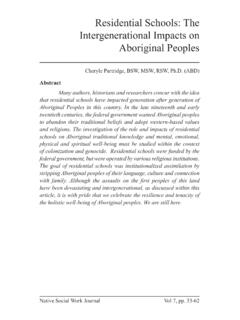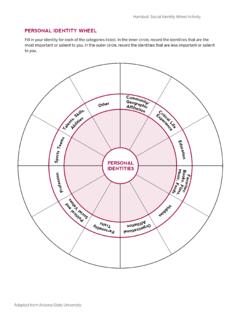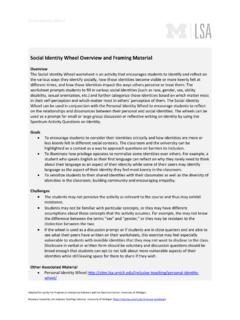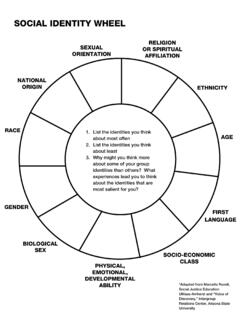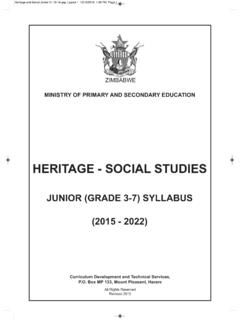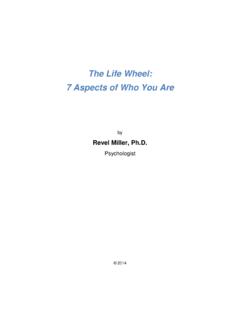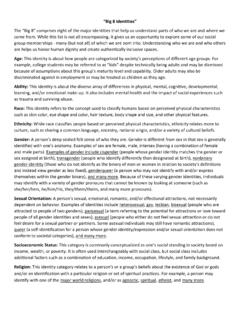Transcription of The Cree Medicine Wheel as an Organizing Paradigm of ...
1 Native social Work Journal Vol 7, pp. 139-161 The Cree Medicine Wheel as an Organizing Paradigm of theories of human DevelopmentAnnie Wenger-Nabigon Abstract This paper explores the Cree Medicine Wheel as an Organizing construct for examining some contemporary theories of human development . Various aspects of Medicine Wheel concepts are discussed along with aspects of knowledge about human development from the mainstream Paradigm (Eurocentric) that is dominant in the academy. Perspectives on indigenous wisdom and ways of knowing are presented from an ecological position linking human development concerns to a wholistic view of human development through the Cree Medicine Wheel . The article highlights aspects of the teachings which deepen understandings of parallels in human development theories . Medicine Wheel teachings support development that maintains positive adaptation to a natural world, and can provide a description of contemporary human developmental theory from the perspective of traditional Aboriginal knowledge.
2 theories about different stages of human development and knowledge about assets that facilitate positive development at each stage are presented, illuminating current concerns in human development theoretical Kinoomaadwin NaadmaadwinAnnie Wenger-NabigonIntroductionThis article uses the foundational structure and teachings of the Cree Medicine Wheel (Nabigon & Mawhiney, 1996) as an organizational structure for examining some contemporary understandings of human de-velopment. human development is defined as the physical, social , emo-tional, intellectual, and spiritual development of the individual human being, as well as the cultural, social , and technological development of human families and societies. The Cree Medicine Wheel mirrors and explains concepts of human development in an elegant and comprehensive manner, but its origin from within the Paradigm of non-western Aboriginal traditions has generally confined it to a position of academic discredit.
3 Medicine Wheel concepts have experienced a rise of influence in academic writing in the recent past. Figure 1 gives an outline of the basic concepts of the Cree Medicine Wheel referenced in this article begins with a brief literature review of Medicine Wheel concepts, followed by a brief description of the fundamental teachings of the Cree Medicine Wheel . (Readers are encouraged to reference Nabi-gon and Mawhiney (1996) for additional explication of the concepts used here.) This is followed by a discussion of several contemporary approach-es to individual human development contextualized by the Cree Medicine Wheel teachings. Concepts of human development arising from the Eurocentric para-digm dominant in the academy cannot be completely integrated into Medicine Wheel models, nor do they subsume Indigenous teachings. The different paradigms do not articulate the other, yet they can be contextual-ized in relationship to each other through deepening our understandings of parallels.
4 (A visual image of the Two-Row Wampum Belt and accom-panying teachings comes to mind). This article contrasts and contextu-alizes different paradigms of understanding human development , and, while attempting to avoid evaluation, is intended to provide a framework for relationship. The goal is to open discussion in the academy of deeper understandings of Indigenous knowledge regarding human development . 141 Native social Work JournalThe Cree Medicine Wheel as an Organizing Paradigm of theories of human development The Medicine WheelThere exists a range of presentations of differing concepts of the Medi-cine Wheel , by writers who are both Aboriginal and non-Aboriginal, who have written with various purposes, some more notable than others. A First Nations Films documentary by Richard Hersley, The Medicine Wheel , presents an artistic, balanced and integrated overview of the Medicine Wheel and includes research on stone Medicine Wheel sites worldwide (Hersley, 2005).
5 This film conveys the integral idea of spiri-tuality which is embedded in the concepts of the Medicine Wheel across time, place and Medicine Wheel has also been used clinically in various treatment settings. Coggins (1990), a therapist, acknowledges his own heritage (Ojibwa and Ottawa) as well as influence from other Canadian, Alaskan, Mexican and American Southwestern cultures, but does not make clini-cal distinctions among different cultural representations of the Medicine Wheel (p. 80). Blackwolf Jones, a licensed psychotherapist and national speaker of Ojibwa heritage in the United States, has published in professional jour-nals on the integration of his understandings of the Medicine Wheel , and other traditional ceremonial approaches, into his work as a counselor. In one of his several books he states, The Sacred Hoop is the circumfer-ence of the Medicine Wheel , a healing symbol of balance (Jones, 1996, p. 307). Lewis Mehl-Madrona, , of Cherokee-European descent from the , is a widely published medical doctor and researcher who has made a practice of combining western medical treatments with wholistic and Aboriginal methods of treatment.
6 Lessons from Native American healing practices are described in his books, Coyote Medicine (1997) and Coy-ote Wisdom (2005), and include teachings on the Medicine Wheel from various North American Aboriginal cultures. Some of his most significant uses of Medicine Wheel concepts and other teachings are demonstrated in his work with natural childbirth, mental illnesses, diabetes, cancer and other severe illnesses (Mehl-Madrona, 1997; 2005).142 Nishnaabe Kinoomaadwin NaadmaadwinAnnie Wenger-NabigonNabigon and Mawhiney (1996) provide a deep description of the Cree Medicine Wheel in the context of social work treatment theories . They present this model as an ..approach to healing individuals, groups, and communities (p. 18). The primary author (of Oji-Cree descent) acknowl-edges the original teachings and training he received over many years from Cree Elders, including Elder Eddie Bellerose from Alberta, and oth-ers, who guided his work and provided the foundational knowledge and theory found in the chapter.
7 Nabigon (2006) goes deeper into the Cree Medicine Wheel concepts through his autobiographical account of its use as a personal healing , Coggins, Mehl-Madrona and Nabigon all work from the stance of the Medicine Wheel as a sacred source of healing. The theme of sacred-ness is at the heart of all Medicine Wheel teachings used by Aboriginal peoples in North America. Sacredness is not generally an aspect referred to in western, or Eurocentric, models of knowledge and healing, but is fundamentally integral to understanding Aboriginal theory and praxis. The Medicine Wheel is a pathway for healing among many Aboriginal peoples across the continent, used in reclaiming identity and purpose for individuals and communities. Seeing the World with Aboriginal Eyes: A Four Directional Perspective on human and non- human Values, Cultures and Relationships on Turtle Island (2005), by Brian Rice, , is an exploration of the world view of Aboriginal traditional knowledge through concepts of the Four Sacred Directions.
8 This work provides a window into the following: patterns of thought; concepts of time, sacredness and the natural world; develop-ment and role of consciousness, perception, language, dance and song; understandings of relationships (metaphorical and literal); morality and ethics; the environment; knowledge, wisdom stories and creation stories; and many other aspects of Aboriginal traditional knowledge. The author works to provide a bridge between traditional knowledge and western knowledge, and explores some connections of understandings from the different ways of knowing, including the perspectives of Aboriginal cul-tures from other continents. Rice (2005) states, There are a number of correlations that one can make between Aboriginal understandings of consciousness and Jungian psychology (p. 65).143 Native social Work JournalThe Cree Medicine Wheel as an Organizing Paradigm of theories of human development Jung s development of the theory of the collective unconscious, its com-position of.
9 Archetypes or primordial thought patterns that can become conscious and give form to psychic contents (p. 65) comes very close to an understanding of the development of the Aboriginal psyche that ..play[s] an integral part in forming the Aboriginal (p. 66). Rice s work encompasses all the concepts of human development from birth through death as perceived through Aboriginal knowledge sys-tems, compared to western knowledge systems based on technology that has ..advanced by leaps and bounds in the past few (p. 83). He writes, What is being lost in this process is knowledge that is learned through introspection such as the introspection practiced through prayers, dreams and meditation (p. 83).The Cree Medicine WheelFew academic works exist describing specifically the Cree Medicine Wheel theory, necessitating reliance on first generation peer-reviewed publications. Hart (2002) includes the Medicine Wheel , and the Cree Medicine Wheel , as part of his excellent foundational approach to Ab-original helping, but does not focus solely on teachings from Cree Elders.
10 The Cree version of the Medicine Wheel as put forth by Nabigon and Mawhiney (1996) appears in the academy for the first time in a theory textbook for social Work (Turner, 1996). In their work, human develop-ment concepts are described through discussion of the Four Sacred Direc-tions in terms of two aspects of life external and internal. They write: There are two parts of life that each person needs to pay atten-tion to or risk cultivate our external self to fit into the current culture and take care of our inner life by personal reflection we change and grow spiritually (p. 21).The Cree Medicine Wheel is conceptualized as a circle divided into four quadrants. The inside of the circle represents the positive (light), the outside represents the negative (dark), with the center representing the core of the person, which also has a light and dark side. This establishes a visual structure (refer to Figure One) of the Aboriginal theory which is applied to understanding human development , providing problem iden-144 Nishnaabe Kinoomaadwin NaadmaadwinAnnie Wenger-Nabigontification tools and solution identification pathways when things are out of balance.
